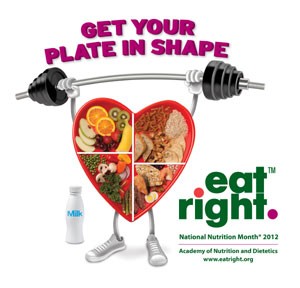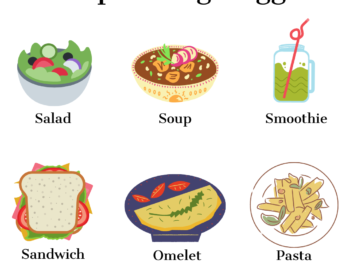March is National Nutrition Month©, an annual nutrition education
campaign created by the Academy of Nutrition and Dietetics (formerly
the American Dietetic Association) to focus attention on the importance
of making informed food choices and developing healthy eating habits.
This year’s theme, “Get Your Plate in Shape,” encourage consumers to
ensure they are eating the recommended amounts of foods from each food
group: fruits, vegetables, grains, protein and dairy.
Here are some practical tips to get YOUR plate in shape:
Fill half of your plate with fruits and vegetables. Choose a colorful
variety of fruits and veggies; the different colors impart different
nutrients and health benefits. Be sure to include dark leafy greens
such as spinach and romaine lettuce as well as and some orange choices
such as carrots, cantaloupe, and butternut squash. Fresh fruit and
veggies are great but so are frozen varieties. Choose fresh fruit
instead of juice.
Practice portion control. Eat realistic portion sizes by using smaller
plates and bowls. Get into the habit of dining at home, where you can
control the ingredients of the foods you eat.
Snack wisely. Add fruit and veggies to snacks too. Enjoy baby carrots
and hummus, celery and peanut butter, fresh fruits such as apples,
pears, and berries
Choose whole grains. At least half of your grains should be whole
grains. This includes oatmeal, brown rice, whole wheat bread, whole
wheat pasta, and other grains such as soba noodles, millet, and
quinoa.
Drink low-fat or fat-free milk. These have the same valuable nutrients
without the calories calories from fat, which is mostly in the form of
saturated fat.
Choose healthy proteins. Eat fish at least twice a week. Good choices
include salmon, sardines rich in omega 3 fatty acids. When you eat
meat, choose lean cuts, and when selecting poultry be sure to remove
the skin. Include plant based proteins such as beans and legumes.
Slash salt and empty calories. Check out labels when you go food shopping.
Get rid of sugary drinks and opt for water instead. Watch out for
added sugars and foods high in sodium.
Eat WHOLE foods and limit processed foods. Choose more fresh fruit and
veggies, and less refined junk food.
Include alcohol in moderation. Limit your alcohol intake to one drink a day for women and two for men.




